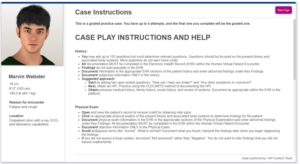COURSE:
NR509: Advanced physical assessment
NR509 Week 2: Advanced Techniques for a Physical Examination: Marvin Webster

General Instructions
Throughout this course, you will have opportunities to engage with simulated patients using the i-Human virtual learning environment. For this assignment, you will complete the i-Human practice case and score your performance using the i-Human grading rubric. Completing the practice case and applying the grading rubric will help you learn to navigate the virtual simulation software, engage effectively and proficiently with a virtual patient, and understand grading expectations for i-Human assignments.
Open and review the grading rubric for the i-Human Virtual Patient Encounter. You may choose to download or print the rubric to use as a reference during your virtual encounter.
Access the i-Human practice case by clicking the link provided below. Clicking the blue bar will launch the activity in a new browser window. You do not need to complete the case in one sitting; if you leave the case and return later, the program will begin where you left off.
All graded documentation, including the Management Plan, must be completed within the i-Human platform. Follow the i-Human Documentation Guide. and the grading rubric as you prepare your client’s EHR and management plan.
Include the following sections (detailed criteria listed below and in the grading rubric):
Complete the following components in the i-Human Virtual Patient Encounter for the practice case for Marvin F. Webster.
- Focused Health History
- Complete a focused health history. Scores are automatically calculated within the i-Human platform when the health history is submitted.
- Focused Physical Exam
- Complete a focused physical exam. Scores are automatically calculated within the i-Human platform when the health history is submitted.
- EHR Documentation (Subjective Data): Document the history of present illness (HPI) and focused review of systems (ROS). Documentation must be:
- accurate
- detailed
- written using professional terminology
- pertinent to the chief complaint
- includes subjective findings only
- EHR Documentation (Objective Data): Document physical exam findings. Documentation must be:
- accurate
- detailed
- written using professional terminology
- pertinent to the chief complaint
- include objective findings only
- Key Findings: Organize key findings from the history and physical exam.
- Problem Statement: Document a brief, accurate problem statement using professional language. Include the following components:
- name or initials, age
- chief complaint
- positive and negative subjective findings
- positive and negative objective findings
- Management Plan: Use the expert diagnosis provided to create a pertinent comprehensive evidence-based management plan. If a specific component of the management plan is not warranted (i.e., no referrals are appropriate for the virtual patient) document that no intervention is warranted. Include the following components:
- diagnostic tests
- medications: Type a specific prescription for each medication, including over-the-counter medications
- suggested consults/referrals
- client education
- follow-up, including time interval and specific symptomatology to prompt a sooner return
- Provide rationales for each intervention and cite at least one relevant scholarly source as defined by program expectations
- Click ”Submit” once the case is complete. Use this guide to download the Performance Overview Report..
- Reflection: Download this worksheet.. Type your reflection responses on the worksheet and upload the worksheet including the title page to the designated drop box for the assignment in Canvas.
- Assess your ability to gather information on your client within the i-Human Virtual Patient Encounter.
- Use the i-Human score sheet to review your results for the focused health history and focused physical exam. How did you perform?
- What did you find easy or difficult about navigating through focused health history and focused physical exam sections of the case?
- Describe one strategy to improve your performance in the next Virtual Patient Encounter.
- Assess your performance in documenting your findings on the electronic health record (EHR).
- What did you find easy or difficult about navigating through the documentation of history and physical within the system?
- Did you document all required components in the case?
- Describe one strategy to improve your performance in the next Virtual Patient Encounter.
- Assess your ability to gather information on your client within the i-Human Virtual Patient Encounter.
- Assess your performance in determining key findings and reviewing the most significant active problem.
- What did you find easy or difficult about navigating through the key findings and organization section of the case?
- How did your key findings compare with the expert’s findings?
- Describe one strategy to improve your performance in the next Virtual Patient Encounter.
- Assess your performance in creating and documenting a problem statement within the i-Human case.
- What did you find easy or difficult about creating the problem statement?
- How did your problem statement compare with the expert’s response provided?
- Describe one strategy to improve your performance in the next Virtual Patient Encounter.
- Assess your performance in creating and documenting a management plan within the i-Human case.
- What did you find easy or difficult about creating the management plan?
- How did your management plan compare with the expert’s response provided?
- Describe one strategy to improve your performance in the next Virtual Patient Encounter.
Solution
